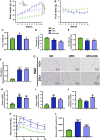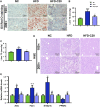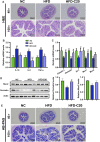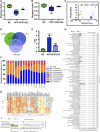Crocin-I Protects Against High-Fat Diet-Induced Obesity via Modulation of Gut Microbiota and Intestinal Inflammation in Mice
- PMID: 36034852
- PMCID: PMC9403484
- DOI: 10.3389/fphar.2022.894089
Crocin-I Protects Against High-Fat Diet-Induced Obesity via Modulation of Gut Microbiota and Intestinal Inflammation in Mice
Abstract
Crocin-I can regulate physiological changes in the human body by altering inflammation and microbial composition. Gut microbiota are also involved in modulating the pathophysiology of obesity. However, crocin-I's effect on obesity and the mechanism underlying its effects on gut microbiota and inflammation remain poorly understood. Here, high-fat diet (HFD) -induced obese mice were administrated crocin-I (20 mg/kg/day) for 10 weeks using an oral gavage (HFD-C20 group). HFD-C20, HFD, and Normal chow (NC) groups were compared. The fat content, colon tissue inflammatory cytokine levels, gut microbiota, and short-chain fatty acids (SCFAs) levels were measured. We show that crocin-I reduced body weight and liver weight and improved glucose resistance in HFD-induced mice, and reduced the lipid accumulation in the liver. Strikingly, crocin-I alleviated intestinal microbial disorders and decreased the F/B ratio and the abundance of Proteobacteria in HFD-induced obese mice. Crocin-I also rescued the decrease in the levels of SCFAs and repaired altered intestinal barrier functioning and intestinal inflammation in HFD-induced obese mice. These findings indicate that crocin-I may inhibit obesity by modulating the composition of gut microbiota and intestinal inflammation.
Keywords: crocin-i; gut microbiota; inflammation; lipid metabolism; obesity.
Copyright © 2022 Xie, Zhang, Sun, Wang, Zhu, Shu, Wu and Li.
Conflict of interest statement
The authors declare that the research was conducted in the absence of any commercial or financial relationships that could be construed as a potential conflict of interest.
Figures





Similar articles
-
Modulating effects of crocin on lipids and lipoproteins: Mechanisms and potential benefits.Heliyon. 2024 Apr 3;10(7):e28837. doi: 10.1016/j.heliyon.2024.e28837. eCollection 2024 Apr 15. Heliyon. 2024. PMID: 38617922 Free PMC article. Review.
-
Orlistat and ezetimibe could differently alleviate the high-fat diet-induced obesity phenotype by modulating the gut microbiota.Front Microbiol. 2022 Aug 15;13:908327. doi: 10.3389/fmicb.2022.908327. eCollection 2022. Front Microbiol. 2022. PMID: 36046024 Free PMC article.
-
Ferulic acid improves intestinal barrier function through altering gut microbiota composition in high-fat diet-induced mice.Eur J Nutr. 2022 Oct;61(7):3767-3783. doi: 10.1007/s00394-022-02927-7. Epub 2022 Jun 22. Eur J Nutr. 2022. PMID: 35732902
-
Lingguizhugan decoction alleviates obesity in rats on a high-fat diet through the regulation of lipid metabolism and intestinal microbiota.Front Microbiol. 2024 Nov 13;15:1462173. doi: 10.3389/fmicb.2024.1462173. eCollection 2024. Front Microbiol. 2024. PMID: 39606109 Free PMC article.
-
Phlorizin ameliorates obesity-associated endotoxemia and insulin resistance in high-fat diet-fed mice by targeting the gut microbiota and intestinal barrier integrity.Gut Microbes. 2020 Nov 9;12(1):1-18. doi: 10.1080/19490976.2020.1842990. Gut Microbes. 2020. PMID: 33222603 Free PMC article.
Cited by
-
Modulating effects of crocin on lipids and lipoproteins: Mechanisms and potential benefits.Heliyon. 2024 Apr 3;10(7):e28837. doi: 10.1016/j.heliyon.2024.e28837. eCollection 2024 Apr 15. Heliyon. 2024. PMID: 38617922 Free PMC article. Review.
-
Exploring global research status and trends in anti-obesity effects of traditional Chinese medicine through intestinal microbiota: a bibliometric study.Front Cell Infect Microbiol. 2023 Nov 16;13:1271473. doi: 10.3389/fcimb.2023.1271473. eCollection 2023. Front Cell Infect Microbiol. 2023. PMID: 38045760 Free PMC article.
-
Lactiplantibacillus plantarum 06CC2 upregulates intestinal ZO-1 protein and bile acid metabolism in Balb/c mice fed high-fat diet.Biosci Microbiota Food Health. 2024;43(1):13-22. doi: 10.12938/bmfh.2023-002. Epub 2023 Jul 31. Biosci Microbiota Food Health. 2024. PMID: 38188659 Free PMC article.
-
The diarrheal mechanism of mice with a high-fat diet in a fatigued state is associated with intestinal mucosa microbiota.3 Biotech. 2023 Mar;13(3):77. doi: 10.1007/s13205-023-03491-5. Epub 2023 Feb 6. 3 Biotech. 2023. PMID: 36761339 Free PMC article.
-
Pregnancy Protects against Abnormal Gut Permeability Promoted via the Consumption of a High-Fat Diet in Mice.Nutrients. 2023 Dec 8;15(24):5041. doi: 10.3390/nu15245041. Nutrients. 2023. PMID: 38140300 Free PMC article.
References
-
- Boscaini S., Cabrera-Rubio R., Golubeva A., Nychyk O., Fülling C., Speakman J. R., et al. (2021). Depletion of the Gut Microbiota Differentially Affects the Impact of Whey Protein on High-Fat Diet-Induced Obesity and Intestinal Permeability. Physiol. Rep. 9, e14867. 10.14814/phy2.14867 - DOI - PMC - PubMed
LinkOut - more resources
Full Text Sources

